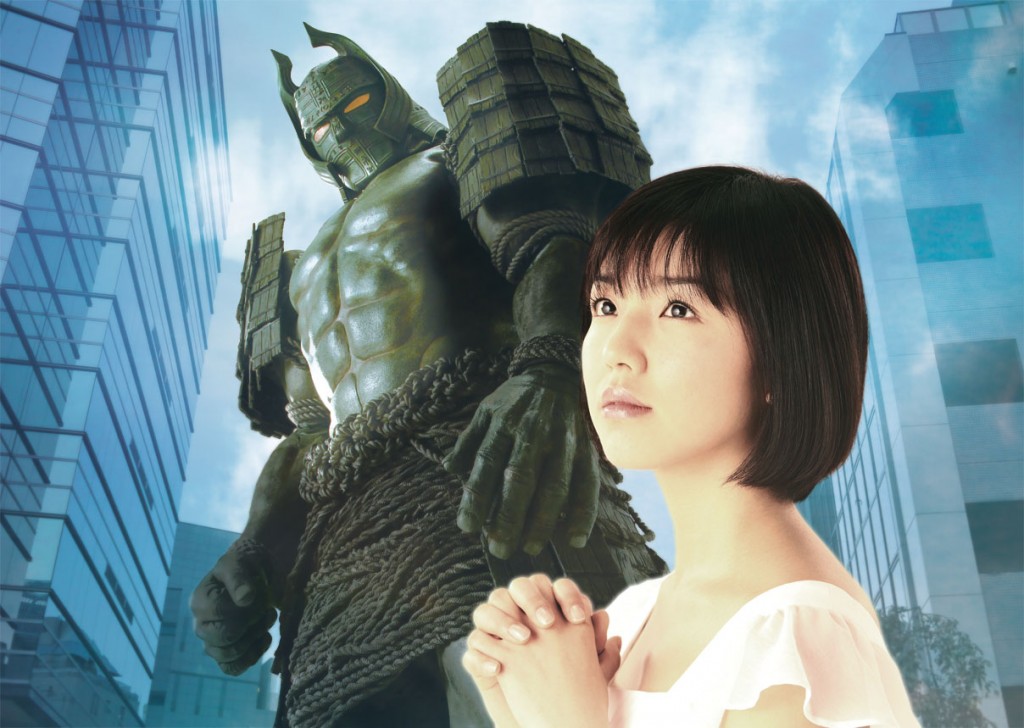
This article was originally posted on October 28, 2010
Produced by Kadokawa Pictures, and premiered on 2 April 2010, Daimajin Kanon is a retelling of the original Daimajin (1966) story in modern Japanese setting. This new series ran for 26 episodes and ended its run on 1 October 2010.
WHAT WAS IT ABOUT?
On the first look, one will mistake it for a ‘giant-hero’ Tokusatsu series, which is not entirely wrong. The original trilogy of the Daimajin movies tells the story of a giant samurai being that goes around fighting evil warlords in the ancient Japanese times. But do note, the giant Daimajin (Bujin-sama or Daimahito as they call him) will not appear until towards the end of the series. Hence, the protagonists of this series is not Daimajin itself, but Taihei and Kanon Misaki, which I will introduce below.
Oishi Shinji, the head writer of Daimajin Kanon will not be a stranger to most Tokusatsu fans, especially Kamen Rider fans. Shinji Oishi was the writer for Toei’s Kamen Rider Hibiki in 2005. In the team of directors working together on this series, the most prominent name will probably be Miike Takeshi, who directed both Zebraman movies and some of Ultraman Max episodes. What made the crew more awesome was the inclusion of famed composer Sahashi Toshihiko who was responsible for the soundtracks of Kamen Rider Kuuga, Kamen Rider Agito, Kamen Rider Hibiki, Ultraman Mebius and an entire list of other popular Tokusatsu and Anime series and movies.
The story was about a girl by the name of Kanon Misaki (played by Rikuna Yuka), who ventured from her hometown of Yamagata, to Tokyo to seek her dream of becoming a singer. As the series unfolds, Kanon’s character turned from an absolutely reserved and untrusting one to her supposed, originally, cheerful one. And she became very attractive from that part on. In my honest opinion, Kanon’s depressed state for the first few episodes did affect my mood a little bit.
In this series, evil demons or spirits, known as Ipadada, existed in Japan. Ipadadas were spirits of deceased humans who carried strong vengeance to their deaths. To kill and absorb more souls to become stronger, Ipadada have to first possess a human body. I won’t spoil the stages of the Ipadada here, and I also won’t spoil on what will happen after the Ipadada absorbs 100 souls. But one thing is for sure, the Ipadada and its summons WERE freaky.
Fighting the Ipadadas were a team of demons, called Onbake. “On” meant Gratitude, and “Bake” meant Demon, which is Gratitude Demons. Onbake were originally either a form of living thing, or a non-living thing in their past life. They reincarnated into human forms because of the love and care that their previous owners had showered them with. And as told in the story, Onbakes were created to show gratitude to humans.
Taihei, the protagonist of this series (played by Mashima Hidekazu), plays a Helmet Onbake who was tasked on a mission to search for the Uta-hime, who turns out to be Kanon. The Inori Uta, the main focus topic of Daimajin Kanon was actually a summon song for the Bujin (or Daimajin) who has turned into rock. And Taihei’s mission was to look for Kanon, to ask for her to sing that song to summon the very first Onbake, the Daimahito (or Bujin-sama as they call him in the show).
OPINIONS
As a story written by someone who wrote Hibiki (the first half of it), Daimajin Kanon can be seen as how Hibiki would originally have been, if not for Toei slapping the Kamen Rider label onto it. The story focuses on character development and interaction between characters. Do not, I repeat, do not watch Daimajin Kanon if you expect end to end action with arrogant hero wannabes or flashy looking characters. Daimajin Kanon was almost like a carbon copy of Hibiki, with down-to-earth, cheerful, matured, fun, and sometimes cheesy characters. But when the fighting starts, it was pretty awesome. The fights were all well choreographed. Not to mentioned the pretty spine tingling exorcism in one of the episodes after they managed to capture the Ipadada.
It could be due to the purpose of Onbakes, that they were made for the purpose of ‘showing gratitude to humans’, that you see them trying to help people, even strangers throughout the series, that made this series not so heavy hearted. With regards to the villians of this show, from the first episode to the last, there have been only really ONE Ipadada, aside from the many summons that it created. That is why I said above, if you expect end to end action, you can give this series a miss. But if you liked how the Hibiki was did before they had a change of writers, I highly recommend Daimajin Kanon to you.
According to what I read on the internet, Daimajin Kanon seemed to be the most expensive Tokusatsu produced this year, having a budget of 1 billion yen for 26 episodes. The graphics were very well done, and the music fits into every scene nicely. The opening song even has Canon in D as part of the composition! (See the pun now? Kanon/Canon) The acting was pretty good as well. And with Nagasawa Nao in the series as a goldfish Onbake, there was quite some fan-service; and I won’t say anything about it here.
Daimajin Kanon has very likeable main characters, but also has a bunch of sub characters that makes you want to kick and punch them in the face before throwing them down the mouth of the volcano. Not to mention the uber-cute Buchinko that always hides in Nagasawa’s cleavage.
If you liked Hibiki, you will probably not be disappointed by Daimajin Kanon.
Rating: 3.5 out of 5 Buchinkos